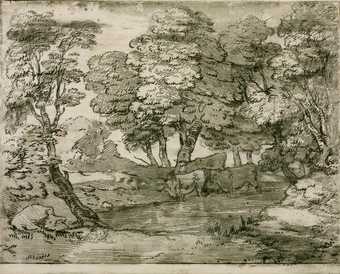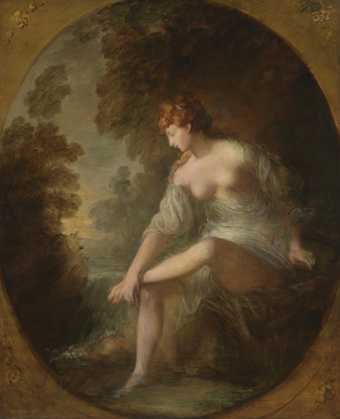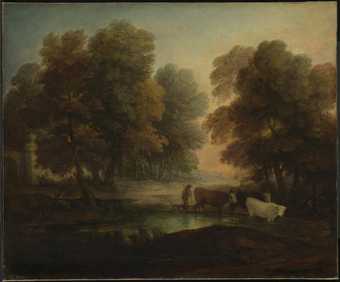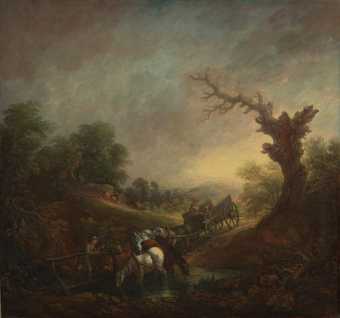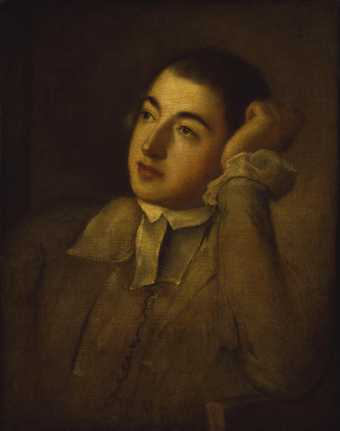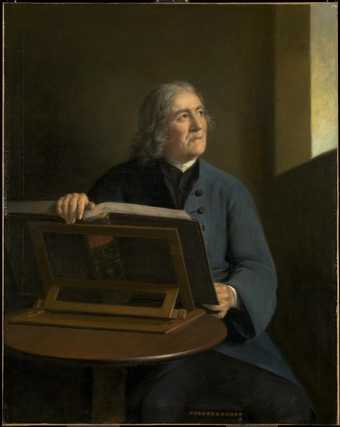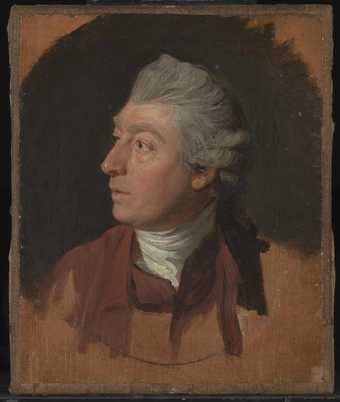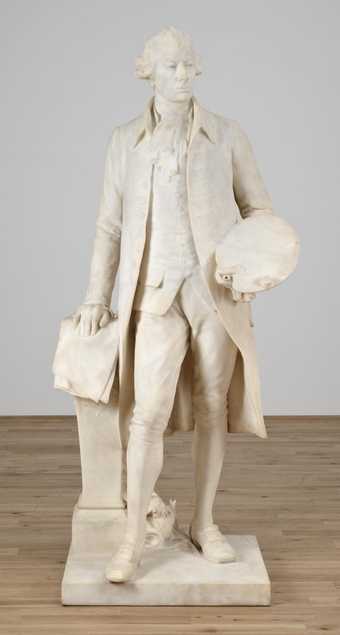In Tate Britain
In Tate Britain
Artist biography
The portrait and landscape painter Thomas Gainsborough was born at Sudbury, Suffolk, the fifth son of a cloth merchant. He was apprenticed at the age of thirteen to a London silversmith, and was taught by Hubert Gravelot, a French book-illustrator. By 1745 he had established his own studio in London. He married Margaret Burr in 1746, and by 1748 had taken up residence in Suffolk. He moved to Ipswich in 1752, and settled at Bath as a portraitist in 1759. He took as an apprentice his nephew, Gainsborough Dupont (1754-97) in 1772. There are no records of any other pupils or assistants. In 1774, established as a fashionable portrait painter, he moved to London, living at Schomberg House, Pall Mall. Despite his great success as a portraitist, he always maintained that he preferred painting landscapes. He wrote to a friend, William Jackson: 'I'm sick of Portraits and wish very much to take my Viol da Gamba and walk off to some sweet Village, where I can paint Landskips and enjoy the fag End of life in quietness and ease' (in Woodall, p.115, no.56).
Gainsborough exhibited at the Society of Artists from 1761 to 1769, and became a foundation member of the Royal Academy in 1768. He first exhibited there the following year, but in 1773 quarrelled with the Academy over the hanging of his pictures, and did not exhibit there again until 1777. In 1784 he again quarrelled with them over the same subject, and never again exhibited at the Academy, instead organising a series of annual exhibitions in his studio at Schomberg House.
He received commissions from the Duke and Duchess of Cumberland in 1777, and from the King and Queen in 1781. He toured the West Country with Gainsborough Dupont in about 1782, and visited the Lake District with Samuel Kilderbee in 1783. Gainsborough died in London after a reconciliation with his great rival Sir Joshua Reynolds, who eulogised him at the Royal Academy, commenting that 'whatever he attempted he carried to a high degree of excellence' (R. Wark, ed., Sir Joshua Reynolds: Discourses on Art, New Haven and London 1975, p.254).
He is buried in Kew Churchyard. A posthumous sale of his pictures and drawings was held at Schomberg House in 1789.
The Tate owns a portrait of the artist by Johann Zoffany (c.1772, Tate Gallery N01487), which is on a long-term loan to the National Portrait Gallery, London.
Further reading:
Ellis Waterhouse, Gainsborough, London 1958, 1966
Mary Woodall (ed.), The Letters of Thomas Gainsborough, revised edition,
1963
John Hayes, Thomas Gainsborough, exhibition catalogue, Tate Gallery, London 1980
John Hayes, The Landscape Paintings of Thomas Gainsborough, 2 volumes, London 1982
Terry Riggs
February 1998
Wikipedia entry
Thomas Gainsborough (14 May 1727 (baptised) – 2 August 1788) was an English portrait and landscape painter, draughtsman, and printmaker. Along with his rival Sir Joshua Reynolds, he is considered one of the most important British artists of the second half of the 18th century. He painted quickly, and the works of his maturity are characterised by a light palette and easy strokes. Despite being a prolific portrait painter, Gainsborough gained greater satisfaction from his landscapes. He is credited (with Richard Wilson) as the originator of the 18th-century British landscape school. Gainsborough was a founding member of the Royal Academy.
This biography is from Wikipedia under an Attribution-ShareAlike Creative Commons License. Spotted a problem? Let us know.
Read full Wikipedia entryArtworks
-
Thomas Gainsborough Wooded Landscape with Three Cows at a Pool
c.1785–8, reprinted 1797 -
Thomas Gainsborough Sir Henry Bate-Dudley, Bart.
c.1780 -
Thomas Gainsborough Lady Bate-Dudley
c.1787 -
Thomas Gainsborough Musidora
c.1780–8 -
Thomas Gainsborough Boy Driving Cows near a Pool
c.1786 -
Thomas Gainsborough Sunset: Carthorses Drinking at a Stream
c.1760 -
Thomas Gainsborough Abel Moysey
c.1764 -
Formerly attributed to Thomas Gainsborough ‘The Parish Clerk’ (Edward Orpin, Parish Clerk of Bradford-upon-Avon)
c.1760–70
Artist as subject
-
Johan Zoffany Thomas Gainsborough
c.1772 -
Sir Thomas Brock Thomas Gainsborough, R.A.
1906


